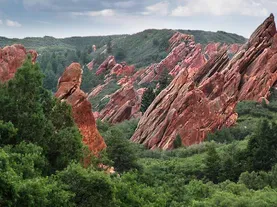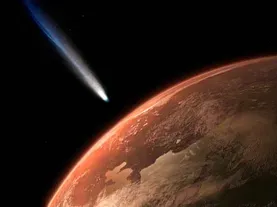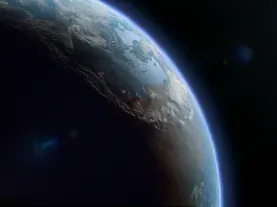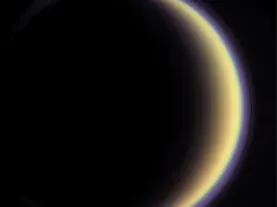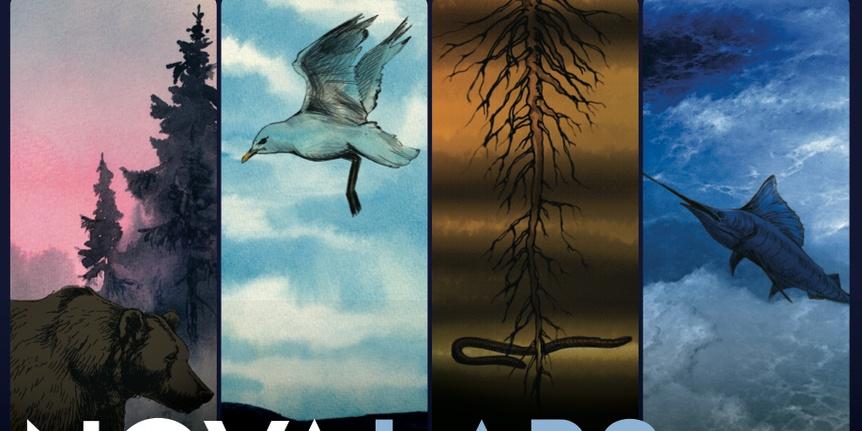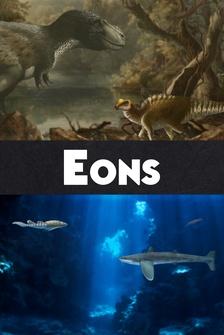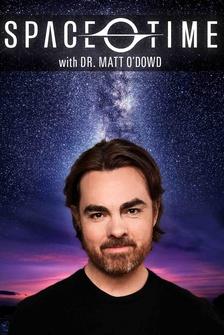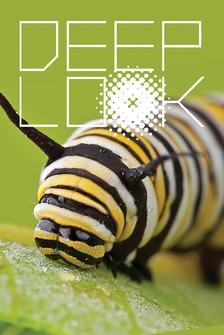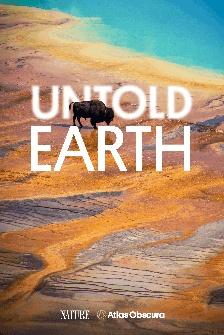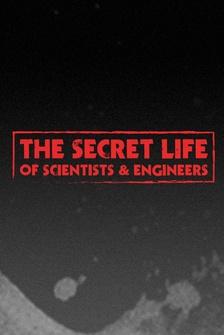♪ ♪ NARRATOR: Earth, our home.
A rocky world enveloped by a thin blue layer clinging to the surface.
Our atmosphere.
ROBERT HAZEN: The atmosphere is the only thing that stands between us and that cold, dark void of space.
(rumbling) NARRATOR: The story of the air that surrounds us is the story of Earth itself.
♪ ♪ SONIA TIKOO: It is incredible to think that this 4.5 billion-year-old rock could hold clues as to how our early atmosphere formed.
(lightning crackling, rain falling) NARRATOR: Clues that reveal colossal transformations.
MIKE WONG: It is absolutely mind-blowing that a tiny bacteria could affect a planetary-scale phenomenon like our atmosphere.
♪ ♪ NARRATOR: How did our atmosphere make Earth a unique place, the only home to life as we know it?
We have never found another planet that has an atmosphere like ours.
PETER GIRGUIS: And understanding how Earth got its atmosphere is the first step in understanding how to protect it.
NARRATOR: "Ancient Earth: Birth of the Sky," right now, on "NOVA."
♪ ♪ (rumbling) NARRATOR: In the depths of space lies a young, unrecognizable planet.
♪ ♪ Bombarded by asteroids, this battered world is our Earth.
♪ ♪ A desolate and volatile globe overlooked by a new-born moon that dominates the sky.
With no recognizable atmosphere, the void of space nearly touches the surface of slowly cooling lava.
♪ ♪ There's little protection from the young sun's harsh radiation.
This world looks nothing like the Earth we know today.
Around four and a half billion years ago, Earth was inhospitable for life.
(rumbling) HAZEN: There were meteors and asteroids bombarding the surface.
It was too hot.
It was a terrible place to be.
♪ ♪ LINGAPPA: The question is, how did our planet transform from this barren rock, into somewhere capable of supporting life?
♪ ♪ WONG: This is the story of how our planet became a living world, and the dance, the co-evolution between life and our atmosphere.
♪ ♪ ("Never Close Enough" by SIPHO.
playing) ♪ Oh, we won't ever hear the silence ♪ ♪ Or ever see the colors ♪ (exploding) ♪ That never lived in our minds ♪ ♪ ♪ ♪ Just a moment ♪ ♪ Never too far out ♪ ♪ Never close enough ♪ ♪ ♪ NARRATOR: Today, our planet is an oasis for life, enveloped by a layer of nourishing and protective gases-- the atmosphere.
It's extremely thin, it's almost like the skin on apple, if you pretended the apple was planet Earth.
TIKOO: The diameter of the earth is about 8,000 miles across, and the atmosphere adds just another 60 or so miles on top of that.
(laughing): We wouldn't... we wouldn't be on planet Earth if it weren't for the atmosphere.
And when I say we, not just you and me sitting here, but any life.
GIRGUIS: Everything from fungi to bacteria, to tiny insects, to giant reptiles, are entirely dependent on this atmosphere of ours.
♪ ♪ It does many things for us, and we can think of the simple answer that we, as human beings, use the oxygen to live.
NARRATOR: Besides oxygen, other important gases make up the atmosphere.
LYONS: Perhaps the single most critical aspect of our atmosphere is the fact that carbon dioxide is one of the greenhouse gases that keeps our planet habitable.
PIERREHUMBERT: Nitrogen is an essential component of the atmosphere, because all life as we know it-- amino acids, DNA, all of the things that are essential to us-- rely on nitrogen.
The atmosphere protects us from ultraviolet radiation because it has a small amount of a molecule called ozone.
LINGAPPA: It controls our climate, which makes this planet, like, a livable temperature for us at all.
It sort of insulates us from the cold of space.
NARRATOR: But the journey to today's atmosphere has been full of drama.
WONG: It's a long, winding road between the initial atmosphere that Earth had through all of the various different kinds of atmospheres in the middle of its history, and finally arriving at the atmosphere that we have now.
♪ ♪ NARRATOR: Millions of years after the birth of the planet, there's still no atmosphere as we know it.
But that is going to change.
Four and a half billion years ago, the Earth would have been a very violent place.
(rumbling) LYONS: Such that it's called the Hadean, which comes from the god Hades, the Greek god of the underworld, because it was imagined to be a hellish kind of place.
(thundering, rumbling) (bursting) (magma rushing) NARRATOR: Across the globe, molten magma surges up from within.
(splashing) Rivers of fire unleash a cocktail of gases.
(booming) ♪ ♪ Carbon dioxide, nitrogen, and methane explode out of volcanoes in thick plumes.
♪ ♪ These are the building blocks of our early atmosphere.
♪ ♪ And we can see echoes of this young planet still on Earth today.
♪ ♪ The volcanoes that we have here in Iceland look very similar to those that we had four and a half billion years ago.
The early Earth was dominated by volcanic activity, and this lasted for millions of years.
♪ ♪ Those volcanoes acted as pathways for the gases that are trapped inside the magma to escape into our atmosphere.
NARRATOR: But how do scientists know what the atmosphere was like in the past?
Surprisingly, clues are hidden in some of the rocks we find today.
Throughout Earth's history and evolution, there's been a dynamic interplay between the Earth's surface and the Earth's atmosphere.
And because of this interplay, there are chemical fingerprints that are trapped in rocks.
The rock I'm holding in my hand is 3.4 billion years old.
And there are tiny bubbles trapped in this rock that are samples of Earth's ancient atmosphere.
So we can measure the gases and piece together evidence of what the atmosphere was like in the past.
♪ ♪ NARRATOR: However, to understand the very earliest atmosphere, scientists have to go back to a time before Earth was formed.
The planet is made up of rock that started as debris floating in the early solar system.
But this debris is also falling to Earth today as meteorites.
WILLIAMS: In my pocket here, I've got the most incredible rock.
This is a chondrite meteorite.
These chondrite meteorites formed when rock dust came together to form small chunks of rock like this.
They eventually smashed together, forming our planet Earth.
And so these are really the building blocks of our planet.
And so it's so humbling, because it's not only older than all of the life that we know on Earth, but even the planet itself, right back to 4.6 billion years ago.
NARRATOR: These rocks are not just the building blocks of our planet, but of our early atmosphere as well.
WILLIAMS: Thanks to these space rocks, the ingredients for our early atmosphere were there.
It's just that they were locked inside the planet.
NARRATOR: Chondrite meteorites are like time machines, allowing scientists to travel back billions of years to when the atmosphere first developed.
WILLIAMS: Experts can study these chondrites in great detail.
They can analyze them in the laboratory to understand their chemical signatures, and that's going to tell them about the gases that they would have contributed to our early Earth's atmosphere, such as water vapor, carbon dioxide, sulfur dioxide, hydrogen, methane, and nitrogen.
HAZEN: It's remarkable that you can learn about the history of the atmosphere going back billions and billions of years just by studying rocks.
WONG: When I learn about this, I feel simultaneously like a time traveler and a detective, being able to piece together the story of our ancient Earth.
LYONS: Each year, techniques become more and more powerful at deciphering bits of information of what the Earth may have been like four and a half billion years ago, that even a short time ago would have been completely a mystery.
(rumbling) (steam hissing) NARRATOR: While the scorching Earth slowly cools, the sky is undergoing a dramatic transformation.
The vast sea of stars becomes obscured.
♪ ♪ And as the young sun rises, color bursts across Earth's sky.
These dense gases are the beginnings of the atmosphere as we know it.
What this fledgling atmosphere looked like is debated.
Because it's hard to know the precise amounts of the various gases it contained.
Gases like methane.
PIERREHUMBERT: If there's enough methane, it can reach a concentration where it starts breaking up under the action of ultraviolet light and then recombining into longer molecules, making these smoggy substances.
That can actually make these hazes which cause an orangey glow.
♪ ♪ NARRATOR: With enough methane, thick, intermittent orange hazes would have covered the planet.
TIKOO: There was probably carbon dioxide.
There might have been carbon monoxide, water vapor.
There might have been some nitrogen or cyanide.
All in all, it was a pretty noxious combination of stuff.
HAZEN: If you were dropped onto early Earth and experienced that early atmosphere, you'd die very quickly because there was no oxygen.
Carbon dioxide, some of the other molecules that might have been present in the atmosphere, you just simply couldn't live on those.
♪ ♪ NARRATOR: And the planet is inhospitable for another reason-- the landscape has never seen a drop of liquid water.
But Earth does have water.
(thunder crackling) It is suspended high above the searing surface, pumped into the atmosphere by volcanoes as water vapor with the other early gases.
♪ ♪ (woman vocalizing, thunder crackling) If this ocean in the sky could reach the ground, it would have the power to utterly transform the planet.
(water rushing) (roaring) ♪ ♪ Today, over 70% of our world is covered in water.
A planet of abundant blue with endless rivers, freezing icebergs, and vast oceans.
♪ ♪ GIRGUIS: Water that we get out of our tap has been through a long journey.
♪ ♪ DOTTIN: And the water on our planet gets incorporated into various aspects of our life, including weather, into the food that we eat.
And because of this, the water is recycled over and over and over again throughout Earth's history.
WONG: So the water that we drink was consumed by dinosaurs and had the first microbes swimming around in it.
(laughs) (distant rumbling) NARRATOR: On the early Earth, water is stuck in the atmosphere.
(wind howling, thunder crackling) But that is about to change.
♪ ♪ High up in the sky, droplets of water, just a fraction of a millimeter across, are condensing.
So light and small, they just float, drifting in the air.
Colliding and merging with others... (squishing) ...they slowly grow until a tipping point is reached.
♪ ♪ Earth's gravity draws them downwards... but the journey is short-lived.
The planet is still hot.
(sizzling) So any drops nearing the ground... (hissing) ...simply evaporate.
♪ ♪ (wind whipping) But over time, that heat is radiating out into space.
Earth is cooling down.
(wind whistling) (fizzing) ♪ ♪ (thunder booming) (rain falling) (lightning crackling) A deluge of rain begins to pour down on the surface.
(booming) (rain pelting down) Huge storms sweep through the atmosphere.
(thunder rumbling) Oceans of water are dumped onto the land.
(rain pouring) (thunder rumbling) ♪ ♪ (lightning striking) The atmosphere has unleashed a key molecule for life.
Water changes the surface of a planet.
It evaporates, it allows clouds to form and rain to fall, it erodes things, and it also became a medium that would eventually harbor life.
(wildlife chittering) Without liquid water, we certainly would not get life as we know it.
♪ ♪ LANE: Things that life needs it to do here on Earth, to have structures like cells, for example, and all kinds of machinery that operate in water, that works really well.
♪ ♪ NARRATOR: The early atmosphere had started a transformation that would set our planet apart from every other in the solar system.
♪ ♪ The young planet is only a few hundred million years old.
The atmosphere has made Earth a water world.
(waves crashing) ♪ ♪ And in that water, something remarkable is happening... ♪ ♪ Arguably, the most pivotal moment in Earth's history.
It would lead to the reshaping of the entire atmosphere.
♪ ♪ So much of this moment is still a mystery.
But we do know that one day on Earth, complex molecules come together to form something never seen on the planet before... Life.
WONG: The origin of life is one of the greatest questions in science, and it's fair to say that we don't know when, where, or how life started.
♪ ♪ (waves crashing) NARRATOR: A shallow rock pool is one of the leading theories.
ANDERSON: People think that shallow pools would have been a potentially important site for the origin of life, because they can get wet and dry over and over again.
(waves lapping) LYONS: Through this repeated cycling of wetting and drying, reflooding and evaporating, maybe through a tide, maybe through seasonal variation, more and more complex molecules can form.
ANDERSON: And that process could've been the precursors for things like DNA, which is what makes up the information in our cells today.
NARRATOR: But there are many other theories about how life could have started.
♪ ♪ LINGAPPA: Some scientists think life began in a deep sea hydrothermal vent.
LANE: Hydrothermal vents are sources of gases-- like hydrogen sulfide, for example-- and provide the kind of reactive conditions between hydrogen and CO2 to make the building blocks of life.
♪ ♪ LINGAPPA: Others think that life originated somewhere completely else, not on the Earth at all, and landed here on a meteorite.
(crashing, booming) All of these different theories have sort of different details, but the punchline is that life needed water, and it needed a way to harness energy.
♪ ♪ NARRATOR: Scientists have some idea what early life might have looked like.
The very first lifeform that existed was probably a little bit of genetic material enclosed in a bubble of fatty material.
♪ ♪ NARRATOR: And while simple, some of these early organisms would have a powerful effect on the atmosphere.
We think that one of the earliest organisms were organisms that produce methane as part of the way they eat, and breathe, and live.
♪ ♪ NARRATOR: They take in carbon dioxide and hydrogen, producing water and methane as waste products.
LYONS: So it is reasonable to estimate that a vast portion of the early atmosphere contains large amounts of methane.
♪ ♪ NARRATOR: This increased methane could have made the orange hazes thicker.
The evolution of our atmosphere is, in many respects, the story of the evolution of life on our planet.
(wind howling) Life can change a planet fundamentally.
But it's always this cause and effect kind of dance between the environment changing life and life changing the environment.
♪ ♪ NARRATOR: And it's the story of life that reveals how we got from this orange hazy atmosphere to the blue, oxygen-rich one we know today.
♪ ♪ This young world is not one we could survive in.
Earth's early oceans are blue-green, full of dissolved iron, and they've absorbed large amounts of carbon dioxide, making them acidic.
(waves crashing) ANDERSON: Early life would have been adapted specifically to living in high temperatures or fairly acidic conditions.
ROTHSCHILD: The ultraviolet radiation was incredibly harsh because there was no ozone layer.
Furthermore, there was no oxygen in the atmosphere; it was a very different composition.
NARRATOR: And some organisms today offer clues to how life survived in this early environment.
♪ ♪ High in the Andes is one of the largest geyser fields in the world.
♪ ♪ LINGAPPA: This environment is extreme for a lot of reasons.
First of all, the water that's coming out of this pool is boilingly hot.
And the altitude means that this environment is subject to a lot of ultraviolet radiation from the sun.
NARRATOR: These are conditions most animals would find toxic.
But amongst the boiling water and steam, life is flourishing.
LINGAPPA: So the colors that we see in these mats around this pool are billions of thriving bacteria that have sort of carved out a niche in this extreme environment.
It's incredible to find so much life, not just surviving, but thriving in these conditions.
NARRATOR: Organisms like these are called extremophiles.
They can survive in environments most complex life would struggle to live in.
LANE: We call them extremophiles because we didn't really think that life could exist in such extreme conditions.
ROTHSCHILD: In fact, we know of organisms that can live up to 122 centigrade.
So this is well over the boiling temperature of water, and, conversely, we know of ones that can live well below freezing.
Bacteria could survive in outer space quite comfortably as well.
These are behaviors that we consider to be extreme because we would die in them.
NARRATOR: Today, life on Earth is prolific, thriving in the most unlikely of places.
From under ice sheets, to acid-filled pools, and the dark, high-pressure depths of the oceans.
And researching these modern extremophiles can hint at what was happening in the early atmosphere.
LINGAPPA: There's been extremophiles as long as there's been life on Earth.
Studying today's extremophiles expands our understanding of what life can do and what life can look like, including trying to understand the earliest life and our most ancient ancestors.
GIRGUIS: Life originated on an earth without oxygen.
So looking at the microbes that live in areas without oxygen helps us understand how they evolved to do well in those environments.
(water fizzing) NARRATOR: But evolving to live in one very specialized habitat can have its drawbacks.
At this period of time in Earth's history, life would have been limited in its energy sources.
LINGAPPA: If you're dependent on something that's being released from a vent in order to generate energy to be alive, you're going to be extremely limited in how fast you can grow.
NARRATOR: Because the energy sources early life used to survive in the oceans were comparatively rare, organisms struggled to proliferate.
PIERREHUMBERT: They had to take various chemicals that were produced by geology and then combine them to release energy.
WONG: But there's about to be a grand innovation by life that will open up a nearly limitless source of energy.
NARRATOR: An innovation that would also change the course of the evolution of the atmosphere.
♪ ♪ Today, life can be found in puddles, lakes, and oceans across the planet.
(waves crashing) LINGAPPA: Our world today is absolutely teeming with life.
Just a single drop of water from the ocean would contain tens of thousands of cells, and among them, you would find organisms called cyanobacteria.
NARRATOR: There are over 2,000 known types of cyanobacteria, and they come in all shapes and sizes.
From long filaments to geometric shapes.
LYONS: Cyanobacteria evolved, as best as we understand, around three billion years ago.
They are astounding, in that they have the ability to adapt to environmental change, and to change the environment because they can be so abundant.
NARRATOR: Cyanobacteria sometimes changed their local environments by creating structures, which they used as habitats to live in.
This is one of the clear-cut examples that life was living even three billion years ago.
This is a formation called a stromatolite.
It's really inspiring that you can pick up a rock like this and read the history of what was happening billions of years ago.
That's an amazing book to read.
♪ ♪ LINGAPPA: Cyanobacteria are some of the most successful organisms ever to live on our planet.
They completely transformed the world.
NARRATOR: This transformation was due to a revolutionary process that changed the fundamental composition of the atmosphere.
Around three billion years ago, Cyanobacteria are developing a unique way to produce energy.
They capture sunlight and use it to combine hydrogen from nearby water molecules... with the carbon dioxide dissolved in the oceans.
With this, they make carbohydrates... And a very reactive waste product-- oxygen.
LINGAPPA: So this vial contains a culture of cyanobacteria that I grew.
And these are cyanobacteria of today, but they are descended from the organisms that first evolved the ability to do oxygen-producing photosynthesis.
LANE: There are these moments in the history of life that seem to have only happened once.
Oxygen-producing photosynthesis is one of them.
Was it a freak accident?
We just don't know.
Suddenly, the oceans became the fuel.
It allowed life to scale up at least tenfold.
NARRATOR: Lifeforms can now make energy using one of the most abundant raw materials on the planet's surface: water.
This kind of photosynthesis now enables organisms to get energy from virtually anywhere, allowing them to spread throughout the oceans.
One cyanobacteria cell becomes two; two become four.
Multiplying again and again... until there are trillions.
And we can still find evidence of them everywhere we look, including in the harshest environments.
LINGAPPA: If you look really closely in the mats in this pool, you can see in some of these greener areas little bubbles that are literally the oxygen being produced by them doing photosynthesis right now.
Cyanobacteria demonstrate the power of life on Earth like nothing else does.
Over two billion years ago, the ancestors of these extraordinary microbes unlocked this spectacular ability.
LANE: Cyanobacteria were the first, and the only, organisms that ever evolved oxygen-producing photosynthesis.
As soon as they cracked the problem of how to use water as a fuel, the oceans became the fuel, and they could live almost anywhere.
These are seaweeds from the ocean-- ooh, right off the West Coast of Scotland-- and oxygen-producing photosynthesis was such a brilliant innovation, that some organisms at that time actually swallowed the cyanobacteria, and that's how we got algae like this.
And then the algae ultimately gave rise to the plants, as well.
(thunder rumbling) NARRATOR: While life was spreading through the oceans, above the waves, the atmosphere was also undergoing a dramatic transformation.
♪ ♪ Over millions of years, tectonic movements in the earth are forging the first large-scale landmass.
And this directly affects the dynamics of the atmosphere.
♪ ♪ (wind howling) Air warmed by the new land drives novel weather patterns across the globe.
(wind blowing) (thunder rumbling) Winds sweep dust high up into the air, where tiny particles seed vast pillars of clouds.
♪ ♪ Something resembling our modern-day weather system is, at last, taking shape.
HAZEN: The appearance of large continental masses had a huge impact on the atmosphere.
We would have seen high-pressure systems, low-pressure systems, prevailing winds, rains, very much like the modern world.
♪ ♪ NARRATOR: Meanwhile, in the oceans, trillions of cyanobacteria are photosynthesizing and producing oxygen.
The first time it has ever been made in significant amounts on Earth.
Oxygen bubbles race upwards.
♪ ♪ But most vanish before they can reach the surface.
(waves crashing) Earth's early atmosphere seems destined to stay as thick orange hazes.
So what is making the oxygen disappear?
The answer lies in a unique property oxygen has.
Oxygen is an extremely reactive element.
DOTTIN: What's unique about oxygen is that it has a chemical makeup that allows it to bond with so many different elements; almost all of the elements that exist.
NARRATOR: And this incredible reactive power is the reason many scientists think oxygen struggled to escape the water.
♪ ♪ Around three billion years ago, Earth's oceans were packed full of dissolved metals.
Metals like iron.
This key that we see here is rusty, and in order to form rust we need three ingredients.
The first is iron, which is what this key is made of, the second is water, or water vapor in the air, and the third crucial ingredient is oxygen.
NARRATOR: And in Earth's early oceans, oxygen began to react more and more with iron and other metals, as cyanobacteria spread across the oceans.
♪ ♪ Below the surface... it's raining.
As oxygen and iron interact, rust particles form in the water, and sink down to the seabed... trapping the oxygen and iron to form solid rock at the bottom of the ocean.
Vast swaths of the water turn red.
LYONS: There were many, many ingredients in the ocean at that time that would readily react with oxygen.
HAZEN: So there was no way for atmospheric oxygen to build up to any significant level.
(seagulls calling) NARRATOR: A record of the reactions that happened long ago can be seen in formations today.
This is a sedimentary rock, meaning it's made up of many different layers that were all deposited on the sea floor over millions of years.
NARRATOR: And this sample is evidence of how iron can react to form solid rock.
This particular sedimentary rock is a banded iron formation, and we can see red color in the rock here, and that red is evidence of iron oxidation or rust.
NARRATOR: As these reactions continued, the metals in the ocean water started to diminish, locked away in the seafloor.
LINGAPPA: Eventually, the oceans would have been depleted of the things that would readily react with the oxygen that was being released.
NARRATOR: But cyanobacteria continued to produce oxygen.
♪ ♪ For up to half a billion years, this oxygen has been trapped in the oceans.
But now, increasing amounts are free to escape.
(water bubbling) ♪ ♪ Over just a few million years, oxygen floods into the atmosphere.
(bubbling intensifies) ♪ ♪ The very composition of the atmosphere itself is changing.
♪ ♪ This is known as the Great Oxidation Event.
DOTTIN: The Great Oxidation Event was one of the most significant periods in Earth's history.
♪ ♪ It was a period of time over which oxygen built up in the atmosphere.
LINGAPPA: Not only did it completely change the environment, it also completely changed the possibilities available for life.
ROTHSCHILD: It is almost impossible to overstate how important the production of oxygen on the Earth was to the history of planet Earth.
All of a sudden, new chemical possibilities arose all over the surface of Earth, and amazing changes were to follow.
NARRATOR: Oxygen is used by organisms today to release energy from the food they eat, so their bodies can use it.
And since oxygen is so reactive, this energy release is immense.
ROTHSCHILD: If you use oxygen, you are 19 times more efficient than an organism that doesn't use oxygen.
♪ ♪ NARRATOR: Because of its reactive power, one of the first consequences of oxygen in the atmosphere is on the rocks themselves.
Now, depending on your perspective, oxygen can be a creative or a destructive force.
♪ ♪ NARRATOR: As it spreads through the atmosphere, oxygen begins to react vigorously with the surface of the Earth.
Rocks with metals like iron react with the oxygen and crumble.
All the elements are in place for vast dust storms to form.
The young world is being ripped up by its own atmosphere.
Earth's surface is changing color as new minerals are created.
TIKOO: We had the formation of all these minerals that did not exist prior to the Great Oxidation Event.
Copper minerals like these, blue and green minerals, yellow and orange, uranium minerals, minerals of molybdenum, minerals of nickel, minerals of cobalt, color of the rainbow, all in new minerals form because of the Great Oxidation Event.
NARRATOR: It isn't just minerals.
Oxygen also makes key nutrients vital for life far more available by reacting with a number of elements to form acids.
Things like sulfuric acid and nitric acid, and acid has this property that when it rains out onto the surface of the earth, it can dissolve rocks, cause weathering and runoff of nutrients and minerals into lakes and oceans.
HAZEN: Those nutrients flowed into the ocean, there were new opportunities for life.
It really was a game changer.
LYONS: And as oxygen began to increase in the atmosphere, the relatively minor elements that are essential for all the processes of life became more abundant.
In many cases, those are metals.
♪ ♪ LINGAPPA: Life on Earth evolved because of the conditions that the Earth provided.
But, in turn, life has completely remodeled the planet, and the world that we know today is, in so many ways, been created by life.
(flamingos squawking) ♪ ♪ NARRATOR: This co-evolution of earth and the atmosphere is apparent everywhere we look.
(waves crashing) ANDERSON: These particular cliffs were formed when dinosaurs walked the earth.
But the beautiful red that you can see in these bands here is formed from the iron in these cliffs combined with water and oxygen to create iron oxides.
So we see an example of oxygen changing the very landscape.
NARRATOR: Oxygen transformed our oceans, reshaped our land, and became a vital ingredient for life today.
But this volatile gas was to have one more dramatic impact on the world.
♪ ♪ Across the globe, oxygen levels are rising, slowly enriching the air, reacting with the methane to form carbon dioxide and water.
(waves crashing) Over millions of years, the orange hazes are fading away.
Sunlight is scattered by the nitrogen and oxygen, producing Earth's first oxygen-rich blue skies.
♪ ♪ In the upper atmosphere, ultraviolet light from the sun causes the oxygen to form a new protective molecule... ozone.
HAZEN: Ozone is made of three oxygen atoms bonded together, and they absorb ultraviolet radiation really well.
So, if you put a little bit of ozone in the atmosphere, it's like sunblock.
NARRATOR: The level of oxygen in the atmosphere will fluctuate over the next two billion years, but eventually, reach the 21% we have today.
♪ ♪ But the story of our atmosphere is not over.
It will continue to evolve, both naturally, and under the influence of human activity.
ROTHSCHILD: If we don't understand the history of the atmosphere, how can we possibly be the stewards of the atmosphere moving forward?
PARAI: Because our atmosphere is totally unique, there's nothing like it that we found on any other planetary body.
WONG: Our atmospheric composition may actually be the thing that is screaming out to the cosmos, a signal to the universe that we're here, that life exists on our world.
DOTTIN: But then, in many ways, we're going back in time, where we're putting all of the chemicals that are toxic to life into the atmosphere.
WONG: Over the past couple hundreds of years, humanity has made a difference in the chemical composition of our atmosphere, most predominantly through the release of carbon dioxide, and this causes myriad effects on our world.
HAZEN: The atmosphere isn't fragile.
But we are.
We can make changes to the atmosphere that will make Earth a very unpleasant place to live.
And so we need to look to ourselves when we think about changes to the atmosphere.
LINGAPPA: We have immense power over our planet.
Our atmosphere is precious.
And, if we change it too much, the whole world will pay the price.
(magma rushing) GIRGUIS: But by understanding the huge and complex steps it took to develop our atmosphere, hopefully, we can develop approaches to take care of it for generations to come.
♪ ♪ ANNOUNCER: On "NOVA: Ancient Earth"... People thought it was an outrageous idea.
The planet completely encased in ice.
CECILIA SANDERS: Some of the deepest, most intense cold Earth has ever experienced.
JAZ MILLAR: Life survived events that scientists previously thought were unsurvivable.
SUSANNAH PORTER: But, for life to flourish again, we would need some kind of drastic change.
(explosion roars) ANNOUNCER: "Frozen," on "NOVA."
Next time.
SINGER: ♪ Wish I could go back in time ♪ ♪ ♪ ♪ ♪ ♪ ♪ ♪ ♪ ♪ ♪


